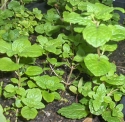If one is good, two is better. Another inch, for good measure. That’s the spirit! You think you’re doing your plants a favor by giving them an extra drink, and the next thing you know, you’re spit-ballin’ with your neighbor over the back fence. “I don’t know what happened, I gave it plenty of water.” Oh yeah you did.
Overwatering is an all-too-common problem in the suburban garden. And it would be wrong to qualify it as a rookie mistake. Even the most experienced gardeners can do it. Here’s a before and after picture of the most recent one that I’m responsible for.
I placed a healthy chocolate mint plant in among my other herbs in a partly sunny area of my garden. Tarragon, rosemary, thyme and basil all grow successfully in the same place. Mint is easy to grow, and not demanding at all. I have a large open area that I need the mint to cover.
I got a little carried away, and decided that my new chocolate mint needed more water than it actually did, and in two short weeks this is the result.
After the initial deep watering at planting, I watered it at least once a day (and sometimes twice), every day for at least 10 days. I started by giving it about three cups of water each time. I noticed that it wasn’t looking healthy so I fertilized it, added some bark mulch and cut back on the water to just one cup, once a day. Too little, too late- the damage was done.
What Happens When You Overwater
It may seem counterintuitive, but you actually starve the plant. When you flood the root zone with too much water, roots die when they cannot adequately absorb oxygen. Days and days of overwatering will compound root damage and accelerate decay. With fewer healthy roots, the plant starves from lack of nutrients and ironically, water.
How Much is Enough
To gardeners, that is a question as perplexing as, “how much do I feed my baby?” is to new parents. To over-simplify, let’s agree the answer could just be, “as much as is needed.” Baby’s cry when they’re hungry and stop drinking when they’re not. Plants just sit there, and die.
Good news for heavy-handed horticulturists is that the signs of overwatering are mostly universal, while the climate, season, temperature and plant’s disease resistance are not. Look for rapid defoliation, usually starting with the lowest leaves on a vertical plant. They will turn yellow and wilt or curl before falling off. Plant stems often turn pale and foliage may become spotted or grow a fuzzy mold. Plant growth all but stops, and the plant loses vitality. This causes it to become vulnerable to pests and harmful organisms that ultimately kill it systemically.
While every garden is different, arguably a good rule of thumb is to start by providing one inch of water per week. Raised beds, especially in hot climates, may need more. Poorly draining garden beds, and gardens in cooler climates may need less. As a general rule, water slowly, deeply and in the early part of the day for best results.
It’s important to observe your plants and the soil in your garden. But don’t just open the faucet because the top soil is dry and crumbly. That’s been my Achilles Heel for years. Instead, grab a trowel and poke around. Dig an inch or two deep into the soil and look for moisture. The soil should not be soppy wet and stinky at that depth, nor should it be too dry and crumbly.
How does your garden grow? Are you heavy-handed with the hose? It’s an easy trap, but with a little know-how, you can turn off the tap and stop overwatering your garden.
This article is the fifteenth in a series of 26 consecutive articles, as part of the Blogging from A to Z Challenge for the whole month of April. Tomorrow, I’ll post an article with a title that begins with the letter “P”… So goes the rest of the alphabet, through the end of the month.


I’m currently drying the roots of an aloe vera. I know, you’re wondering how I managed to over water a succulent. I’m wondering too. I barely gave the poor girl any water and she’s droopy and turning brown after one night. It seems like most of my succulents only ever last a year before I do something terrible to them by mistake. – Sadly this is not the first, and probably not the last time I’ll mess up 😦
I’ve done this before.
I seem to overwater regularly. Easy mistake to make.